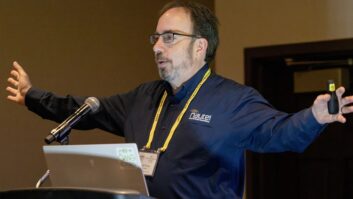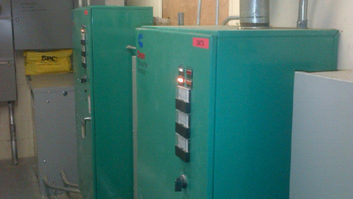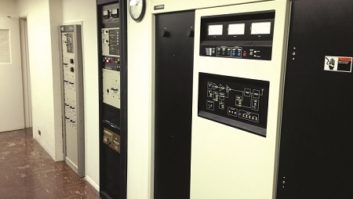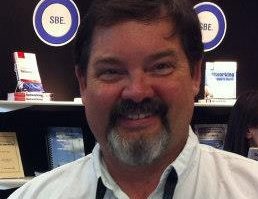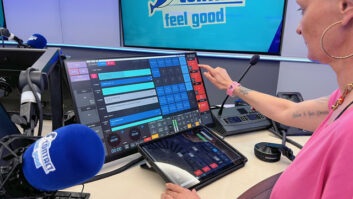Trends in Technology: Alternate Transmitter Sites
Oct 1, 2014 9:00 AM, By Doug Irwin, CPBE DRB AMD
In last November”s Radio Magazine I contributed an article entitled �Building Better Backups.� The running theme through the article was �how badly do you want to stay on the air, really?� I”m going to reprise that theme in this article, with an emphasis on practical solutions.
We all know as broadcast engineers that our primary function is to keep the station on the air and to �drop everything� to get the station back on the air should a failure of some sort take it off. Keeping our stations available to listeners is our business; but whether your station is commercial or non-commercial, there”s a practical limit. Having an alternate transmitter site is the best way to keep your stations �on-air� no matter what. Whether you work in a small or major market, there”s likely an approach you can take within your practical limits, to make such a site available.
Let”s take a look at an unusual occurrence that prompted a large alternate site project.

The Station Fire threatens Mt. Wilson transmitter sites
The Station Fire
Having burned 160,557 acres, the Station Fire was the 10th largest in modern California history, and the largest wildfire in the modern history of Los Angeles County. The Station Fire burned up the slopes of Mount Wilson, threatening nearly all of the television and FM radio transmitter sites on the summit, as well as the Mount Wilson Observatory. Around $100M was spent fighting this fire. (Source: Wikipedia.)
I was working in New York at the time, but I went to the Mt. Wilson webcam many times to see the progress of the fire as it approached the summit.
You may know that Los Angeles is the number 2 market in terms of population, but in fact it”s the number 1 market in terms of revenue. Facing the possibility of their main transmitters sites being destroyed by the fire, major broadcast companies took quick action.
– continued on page 2
Trends in Technology: Alternate Transmitter Sites
Oct 1, 2014 9:00 AM, By Doug Irwin, CPBE DRB AMD
CBS Radio has a large portfolio of FM stations in Los Angeles: KRTH, KTWV, KCBS-FM, KAMP and KROQ. All but KROQ have their main transmitter sites at Mt. Wilson. Lynn Duke is the engineering manager for KRTH, KTWV and KNX 1070. He is also responsible for the FM transmitter sites for KROQ, KAMP and KCBS-FM and was kind enough to assist with this article. Like many other LA radio engineers, Lynn lived through the Station Fire, and gained new experience from it.

Entry to the “bunker” on Verdugo Peak
Not surprisingly, CBS Radio has a long-standing commitment to disaster preparedness and had alternate transmitter site arrangements in place for most of its stations even before the Station Fire. KRTH had a 5 kW backup site at Verdugo Peak; KCBS-FM and KTWV shared a GatesAir ZX-3500 in an N+1 arrangement at Verdugo�meaning that either KCBS-FM or KTWV could be on the air from there. I should note that Verdugo Peak, about 10 miles north of downtown Los Angeles, is the main transmitter site for KROQ.
In 2009 KROQ already had a full-power backup site at Flint Peak, about 3 miles southeast of Verdugo, but with the fire threatening Mt. Wilson, CBS engineers were able to use an emergency antenna notification to the FCC and put the KROQ aux transmitter at Flint Peak on the KAMP frequency (97.1). The Flint antenna is broadband enough to make that work. CBS Radio also has an emergency response vehicle that is posted in LA. The vehicle has a small studio with 3 kW FM transmitter on board, and serves as a shared resource for all of the CBS Radio stations in the Western Region.

Racks at the Verdugo bunker site, including the KAMP auxiliary transmitter, a GatesAir ZX-5000
In the end, the fire was never did burn up to the top of Wilson. All of the transmitter sites survived, but CBS Radio management quickly decided that they needed a more robust system that allowed for all of its FMs to remain on the air in the event of another potential catastrophe such as the Station Fire. The �scare� precipitated a major set of upgrades beginning in 2010. Thanks to Lynn, I had a visit to the site, and I”m able to share that visit with you.
The KROQ/KAMP/KRTH site is actually built inside of an old cold-war relic bunker that is up on top of Verdugo Peak. Once you go down the stairs into the bunker, it looks like most other transmitter sites, except that the equipment complement, the system design, and the construction techniques are absolutely first rate.
– continued on page 3
Trends in Technology: Alternate Transmitter Sites
Oct 1, 2014 9:00 AM, By Doug Irwin, CPBE DRB AMD
KCBS-FM and KTWV are in another building adjacent to the bunker on top of Verdugo.

KCBS-FM and KTWV GatesAir HPX-20 auxiliary transmitters on Verdugo Peak
�We tried to include most of the features we have at our main sites at Verdugo. The thinking was that if we ever did lose Mt. Wilson, we might end up operating the Verdugo site for a prolonged period of time,� said Lynn. �The site has already saved us a few times when there was a serious problem at a main site or when we needed to power down a main site to allow a tower crew to work safely.� The main STL for each of the Verdugo transmitters consists of an Intraplex frame fed by a T1. KRTH also has a 950 MHz backup using a Moseley Starlink. Plans are in the works for 950 MHz hops for the other stations as well. For the time being, backup STLs are provided by Telos Zephyr ISDN codecs. Additionally, each station on Verdugo has its own AudioVault playback workstation, flash media players with updated music and IDs, and for real emergencies, an AM receiver tuned to KNX as well as a TV receiver tuned to KCBS-TV.
The main remote control for each of the stations is a Burk ARC Plus, riding up on IP over T1 from the studio locations. Each site has a secondary dialup remote control as well. A third remote control is planned for each station, consisting of a Broadcast Tools SRC-16 fed via serial data coming up on the 950 MHz STL links. �That last layer gives us control of the critical site functions independent of Telco connectivity,� says Lynn.

Coaxial switch and transmission line routing for KCBS-FM and KTWV transmitters
One thing I”d like to point out is that CBS Radio has built full HD Radio systems at each of its backup sites as well.
Smaller-market strategies
All the problems that exist in larger markets exist in smaller markets as well. Let”s review the basic ones:
- � Both antennas on the same tower? This is an obvious flaw. If the tower falls over because of a weather event, you”re dead. Poor tower maintenance can also be problematic.
- � Access to the transmitter site: Again, think about weather-related events. Can you even get to the transmitter site under all circumstances? Probably not. Is the road too snowy? Is it flooded out because of a hurricane? Have trees fallen over it? Have the authorities closed it down for some reason, like a forest fire?
- � The generator: It”s important to have a reliable generator, clearly. What is the longest power failure you have planned for? Do you have enough fuel to run for a week or so? If not, can you get a delivery, or are they unable to drive up the road? Are they even open for business? Can you get your generator tech on the phone if need be? Can he even get there?
- � Three-phase main distribution panel: If this panel encounters problems, then you”re really in trouble. You can do IR studies and maintain it, but no guarantees of course.
�We”re a smaller market and we simply can”t afford to have an alternate site!� Well, you can say that of course, and you can sit back and do nothing, or you can figure something out. Rarely are there the resources necessary to make the job at hand easy; often times some sort of technological strategy must be employed. Let”s take a look at an example of exactly what I”m talking about.
Continued on page 4
Trends in Technology: Alternate Transmitter Sites
Oct 1, 2014 9:00 AM, By Doug Irwin, CPBE DRB AMD
Townsquare Media”s Tri-Cities cluster (Richland/Kennewick/Pasco, Wash.) provides a great example of �engineering strategy� that you should know about. They built an N+1 site known as �Finley� that serves all four of the company”s FM stations in the market (KXRX, KEYW, KOLW and KORD). Market Engineer Tim Schall described the system for this article.

“Finley” backup site with frequency agile transmitter serves four stations.
The N+1 site is basically composed of a Nautel VS2.5, and a two-bay Bext TFC2K, which is a broadband antenna. Each of the four stations has a licensed auxiliary for 2 kW ERP. All four stations are currently received at the site by their normal microwave channels. Each STL receiver feeds a composite switcher input�and naturally the output of that switch in turn feeds the composite input of the VS2.5.
In order to turn up the site, Tim establishes an IP connection to the transmitter, and then using the Nautel AUI he simply selects a particular profile. A profile is configured in the transmitter for each station�in this case, all that really needs to change is the frequency. Also configured in the profile is a logic high output that is wired to a particular input select on the composite switch. When each profile is selected, the appropriate composite feed is sent to the VS. The station chosen then comes up at the right frequency, TPO, and with the correct audio.
One interesting change that Tim plans in the near future is making use of another available feature in each profile: receiving audio via a Shoutcast or Icecast stream. Townsquare maintains a full 25 Mbps IP radio link to the site. By installing four Barix Instreamers at the common studio location, he”ll be able to have the VS grab the correct audio for each station, replacing the composite STL receivers and switch. This will allow Tim to re-allocate the four STL receivers at their associated main transmitter sites as backups.
As you can tell, quite a bit of time and resources have been invested in this site. I asked Tim for a couple of examples when it came in handy. �Recently, there was a lot of tower work to be done at the KORD site. There are three FMs on that tower. The other two are owned by another company. To maintain NIER compliance, only one station could be on from the tower while the work was being done and it had be at greatly reduced power. Townsquare Media moved the operations to our Finley site and actually got better coverage from there than we would have at the power level necessary from the main site,� said Tim. �There was another instance when the power failed at the KEYW site and it (Finley) was pressed into service. There is no backup generator at KEYW.�

Broadband antenna at the “Finley” site serves as backup for all four stations.
Even with the advantages of an N+1 site, Tim has some warnings that he wants to pass along. �If someone were to build a site like this, or even if I were going to build another one, I would insist on having the discussion of station priority. That is to say, if something happens and two stations are down at the same time, which station gets the backup? My market manager has made it clear which station gets this site if that should happen,� said Tim. Again, this is part of the engineering strategy, but one that is decided along with your local manager and PD.
The approach you take toward establishing an alternate site depends upon the resources available to you. That, in turn, depends upon what is at stake in your particular business circumstance. In smaller markets it may be that you”ll have less to work with, sure. However, that should not be an insurmountable obstacle. Look at tower space that”s under lease or otherwise available inexpensively, figure out a way to make space in the racks for a frequency-agile transmitter, and determine a backup means of getting program audio out to another site. Use your imagination and study what others have done. Borrow their best ideas to help solve your own. That”s how it”s done.
Irwin is RF engineer/project manager for Clear Channel Los Angeles. Contact him at [email protected].
